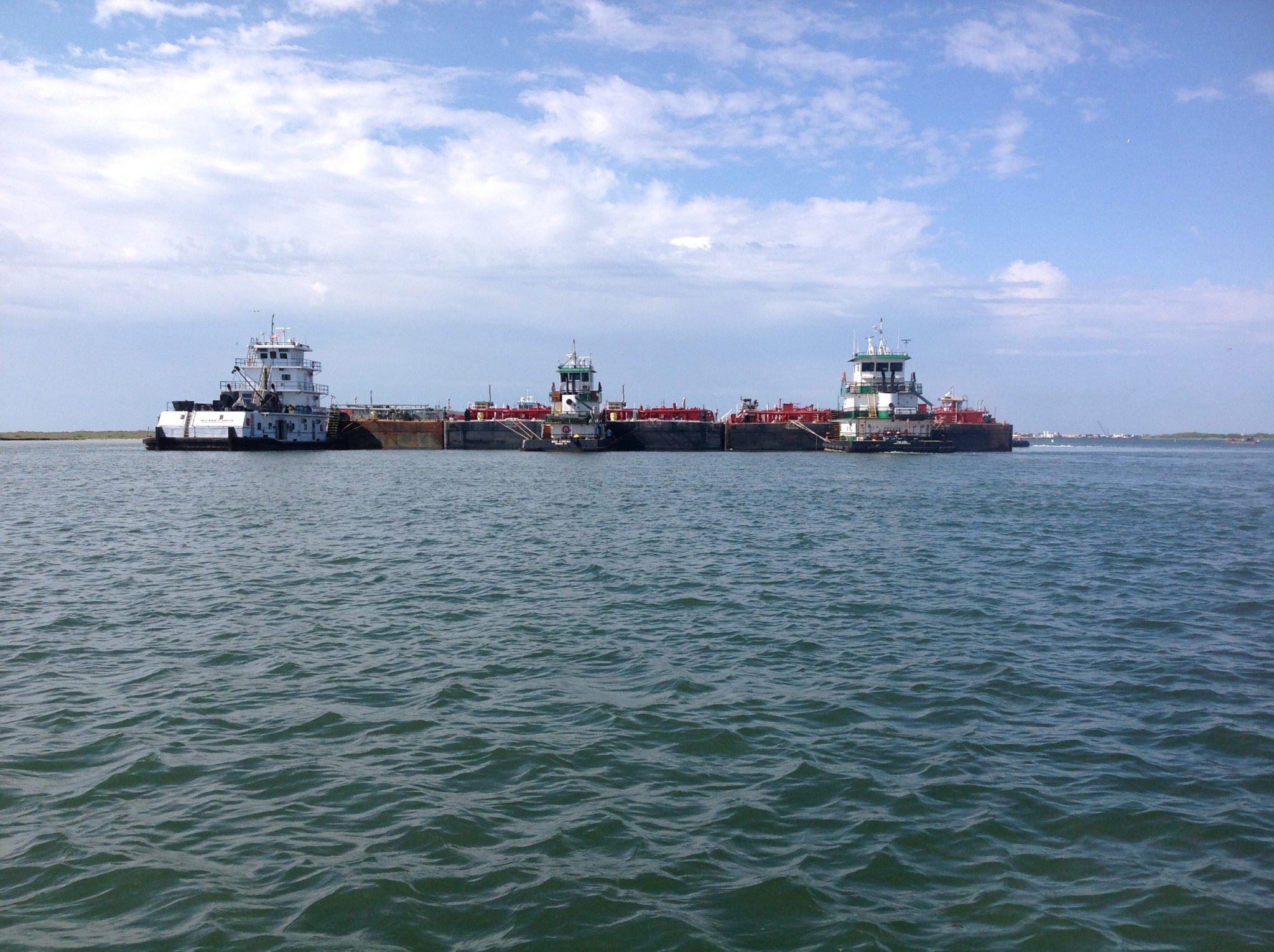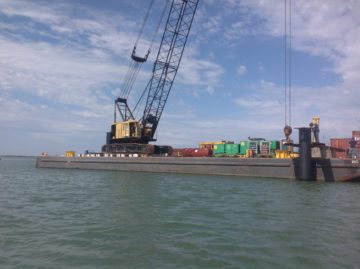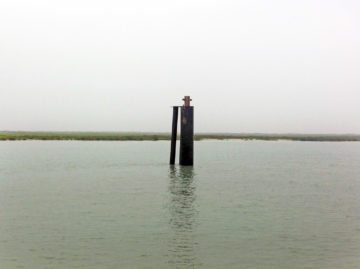
Barging In
How a felon with a fake name convinced a federal agency and the Texas General Land Office to fast-track a controversial project in Port Aransas.

When Mike Edwards walked into the Corpus Christi office of the U.S. Army Corps of Engineers one June afternoon in 2014, he came prepared. His task: convince six state and federal agencies, including the Army Corps and the Texas General Land Office, to sign off on a plan to build a barge mooring facility in an ecologically sensitive part of the Texas coast.
He was flanked by two towboat captains and state Representative Todd Hunter, whose district includes Port Aransas. Hunter is also a powerful lieutenant of Texas House Speaker Joe Straus. The problem, Edwards and his crew told the agencies’ representatives, was that the Port of Corpus Christi had gotten so busy that barges were backed up. While waiting for room at the port, they were idling in Lydia Ann Channel, a small pass tucked just inside San Jose Island on the bay side of Port Aransas. The barges, they said, were nosing up on the shoreline, running their engines and killing seagrass. The proposed temporary mooring facility would stretch for a mile and a half and keep the barges tied up in deeper water, away from the shoreline and off the seagrass.
As a sales pitch, the meeting evidently worked wonders. Six months later, in January 2015, Lydia Ann Channel Moorings LLC had its permit from the Army Corps and a lease from the General Land Office (GLO), which owns submerged lands along the coast. The Army Corps allowed Edwards and his partners to skip public notice and an environmental assessment, even though the project lies within a state scientific area and hosts several endangered species. As salty Port Aransans would quickly point out, Lydia Ann Channel lies within casting distance of an extensive black mangrove estuary made up of tidal channels and flats popular with fishermen stalking redfish, speckled trout and flounder.

For months, Edwards and the principals in the company — his son-in-law Todd Pietsch and Bryan Gulley, an orthodontist and well-known local developer — pressured the Army Corps to fast-track their application. In July 2014, when the Texas Parks and Wildlife Department asked how they planned to protect seagrass that might be affected by the development, Edwards told them in an email there was “NO sea grass.” When a member of the towing industry wrote to the Corps expressing worry about the facility’s effect on other ships and barges passing through the channel, he called the man to convince him otherwise.
But not all was as it seemed. Edwards and his crew would violate the terms of their permit by building a large-scale docking operation, more elaborate than the one they’d pitched the Corps. And Mike Edwards wasn’t actually Mike Edwards. His real name is Everett Michael Skipper, and Everett Michael Skipper has a rap sheet.
Only months later, long after the permit was issued and the dock was in operation, would the residents of Port Aransas discover the truth. For the locals, who have since sued the Corps for granting the facility a permit, the state and federal agencies’ behavior is puzzling. How did a felon talk a $4.6 billion federal agency into fast-tracking a project with so many red flags?
For most of the 2000s, Skipper was a wheeler-dealer in the construction business in Corpus Christi. He functioned as a one-man shop for putting together bars and nightclubs, including Aria Sky Terrace & Lounge, a swanky downtown spot owned by Pietsch.
Skipper took on the role of designer, construction manager, government liaison and all-around problem-solver for these projects, drawing up the plans for the businesses himself and then paying a local engineer to rubber-stamp them. He almost never had employees of his own, choosing instead to hire subcontractors paid off the books.
But Skipper’s business came to an abrupt halt in 2007 when he was rounded up in a bribery sting. Desperate to get a new nightclub opened in time for a highly anticipated baseball game, Skipper gave a city inspector a small Red Bull refrigerator and offered a fire marshal an airline ticket to Hawaii. The fire marshal refused, but the incident brought federal agents knocking on Skipper’s door. A probe would later reveal that not only did Skipper try to bribe city officials, he had signed off on a fire protection permit using his alias, Mike Edwards. The name, he would tell investigators, was his DJ name, which he had used since 1976.
In 2009, Skipper pleaded guilty to bribery. Though he was now a felon, Skipper wasn’t deterred from hustling new business. He just made sure to keep his real name off the paperwork. Though Skipper coordinated behind the scenes with officials at the Army Corps, Pietsch and Gulley signed the Army Corps permit and the GLO lease.
When the Observer told GLO staff in a meeting in October that Edwards’ real name was Everett Michael Skipper and that he was a felon, the room fell silent. An attorney for the agency said it doesn’t conduct background checks or look into the personal histories of applicants.
Still, if officials with the Corps or GLO were curious about Mike Edwards, all they had to do was Google his name.
“Whether caused by incompetence, the good-ol-boy system, apathy, agency capture, corruption, or hostility toward environmental regulatory obligations,” the Port Aransans claim in their lawsuit, permitting the facility was “a grand mistake.”
On a Friday evening in Port Aransas, retirees cruise the streets on golf carts and fishermen returning from a day on the water stop at one of the many cook-your-catch joints for dinner. A beach town lined with bait stands and seafood joints, Port Aransas takes its salty living seriously.
In 2015, when folks in Port Aransas noticed barges with construction cranes in Lydia Ann Channel, there was an uproar. Residents quickly organized, set up a Facebook group and began looking into their legal options. Many of them had grown up in Port Aransas or spent summers in the area, fishing, kayaking and duck hunting. The sight of large metal pilings being driven aground in the channel upset them.
![Andrew Hawkins, an attorney for the Texas General Land Office, denied that the facility is within Redfish Bay State Scientific Area, saying “the [eastern] boundary [of the state scientific area] runs through the middle of the channel.” It does not.](https://www.texasobserver.org/wp-content/uploads/2017/01/portaransas-map3-360x458.jpg)
A young oil and gas attorney, Dyer was also upset that he and the others had never received so much as a notice that Lydia Ann Channel Moorings was planning on building a barging facility. In 2015, Dyer and a handful of wealthy Port Aransans formed the Friends of Lydia Ann Channel, and put up about $350,000 to hire an Austin law firm and sue the Army Corps of Engineers. The Corps, they allege, used “an improper and hurried process” reserved for noncontroversial projects to permit the facility, and grossly failed to protect the Lydia Ann Channel. In court the group would discover that the Corps had decided the project was “minor” because the company had claimed it was a “temporary” facility and therefore didn’t require public notice or an environmental review.
At one point, the Texas Parks and Wildlife Department wrote to the Corps pointing out that the area around the facility is home to marine mammals and sea turtles and recommending that the company set up a monitoring program. The agency also suggested that the company “compensate for the potential impacts to seagrass beds in the immediate project vicinity.”
Seagrass prevents erosion, improves water quality and provides a habitat for marine life from plankton to gamefish; uprooting it in protected areas is illegal under Texas law. But when the Corps passed on the recommendations to Skipper, he responded “there are NO sea grass’ [sic] in location of moorings to be installed” and ignored the suggestion to set up a monitoring program. The Corps didn’t pursue the point either. In fact, some within the Corps were apparently in such a rush to get the mooring facility permitted that they didn’t wait for their colleagues to weigh in.
By about mid-January, officials in the regulatory department had grown impatient with the Corps’ operations division, which was looking into whether the facility would obstruct ship traffic.
“The applicant has been very patient” and we “owe the applicant a permit decision,” one regulatory division staff member wrote.
Kim McLaughlin, the Corps’ regulatory section chief in Galveston, chimed in too.
“We need to move out on this,” she wrote. “Please provide a response ASAP otherwise we will make a permit decision mid-week.”
A few days later, McLaughlin approved the permit before the operations department provided their sign-off.

The Corps declined to comment for this story, citing the ongoing litigation. However, in a blistering review of the events produced after the federal lawsuit was filed, Army Corps Col. Lars Zetterstrom blamed Lydia Ann Channel Moorings for misleading the agency. He wrote that the company “failed to accurately describe the scope of its operations,” which resulted in “an inappropriately narrow scope of review.”
To complicate matters, the official story is full of small but crucial contradictions. On the most basic facts, the government agencies, Port Aransas residents and Lydia Ann Channel Moorings can’t seem to agree.
For example, the GLO denies that the facility is in the Redfish Bay State Scientific Area, a zone designated by the state to protect seagrass from being uprooted. But a spokesperson for the Texas Parks and Wildlife Department, which established the area, confirmed to the Observer that most of the facility falls inside the scientific area.
Another major point of contention is how long the barges had been disturbing the Lydia Ann Channel and whether the company was behind the activity. The Port Aransas residents argue that the company “fraudulently created the ‘industry practice’ of grounding barges on the banks of the channel” and used it “as an environmental bête noir [sic] to obtain exemptions from environmental laws.”
“I firmly believe these guys were calling their buddies and saying, ‘Start nosing up here,’” said David Smith, an attorney for the group of Port Aransas residents suing the Corps. If the court issues an injunction and stops the company from operating, “They’re going to say, ‘Start pushing up again,’” Smith said. “That’s BS on so many different levels.”
Skipper and Gulley’s most effective strategy was to present the project as an environmental savior. In meetings and conversations, they emphasized that barges were already haphazardly pushing up against the shoreline and said that a docking facility would help keep the barges organized and tied up away from the shore.
The strategy worked. The GLO, for instance, still claims the goal of the fleeting project is to “reduce the impact on seagrass.” The agency told the Observer that it received several calls from concerned citizens, but it wasn’t able to provide any record of those calls.
On the other hand, longtime residents of Port Aransas say they only started seeing barges about a year or two before the company proposed the facility. Their suspicion is that Skipper, Gulley and Pietsch used their connections to fast-track the project and avoid public scrutiny. Dyer, for one, is convinced that there was backroom dealing that helped Gulley and Skipper seal the deal on the lease, though he has no concrete evidence to prove it.
Still, Gulley is well-connected. He served on the Corpus Christi economic development board and has been a regular contributor to local and state elected officials. Gulley gave $1,000 to Land Commissioner George P. Bush in 2014. Since 2010, he’s given state Representative Todd Hunter about $8,000. Hunter attended the crucial June 2014 meeting and voiced his support for the project, though his involvement otherwise is unknown. (Hunter did not respond to multiple requests for comment.)
Gulley had worked with the GLO in 2010 and 2012 to secure leases in Corpus and was likely familiar with staff at the agency. He was also a fishing buddy and friend of Rene Garcia, a GLO field biologist. Garcia at one point signed off on a noncompliance notice sent to the company, but the GLO told the Observer that it was incidental and that he will be precluded from work involving Gulley’s leases.
In an emailed statement sent through a public relations firm, Todd Pietsch told the Observer that Skipper “in no way lobbied anyone to fast-track the project” and that the crime his father-in-law committed nine years ago “is completely unrelated and irrelevant to the Lydia Ann Channel project.”
Pietsch said his group evaluated 10 potential sites for the docking facility before settling on the Lydia Ann Channel site because it satisfied several criteria for barge and environmental safety. If the facility were shut down, “the livelihoods of 29 employees is [sic] at risk” he said, and “the practice of grounding barges against the shorelines of Lydia Ann Channel would begin again immediately.”
In September 2016, in response to the lawsuit, the Army Corps revoked the facility’s permit for “not accurately” describing the scope of the operation and misleading the agency about “the underlying need for the project from a public interest review perspective.” Soon after, the GLO told the company its lease was in default and could be terminated immediately.

However, the fleeting facility is still operating. The company has also secured another lease for land on the other side of the channel from the Aransas County Navigation District, but claims that it doesn’t plan to construct another fleeting facility there.
At a November hearing, Judge Janis Graham Jack, the federal judge presiding over the case, seemed annoyed with the Corps for not stopping the company from operating, calling the agency’s defense “a circular argument of the most bizarre.”
“So, who is in charge of them doing this?” she asked the attorney for the Corps. “I mean, [the company’s] whole argument is that, ‘It’s already here, so don’t mess with it.’ … What is the point? I’m still not understanding the point of the permitting process.”
The Corps has told the company that it can still reapply for a fresh permit, and the company is working with the Corps in an attempt to re-permit the facility, this time posting a public notice and conducting a more thorough environmental review. Its attorney made the case at the hearing that if the facility were removed, barges would once again begin grounding into the shoreline.
At best, Dyer and Smith say, Skipper and the rest of his crew hoodwinked state and federal agencies, manipulating the process to suit their needs. At worst, the agencies willingly helped the company sidestep environmental and administrative process laws. The truth, however, might lie somewhere in between.
“These guys from the moorings company are very defiant,” said Dyer. “They took the shortcut, they got the cheap lease, they thought they were clever. They didn’t count on local citizens and homeowners and everybody here getting organized.”
Photos from Lydia Ann Channel Moorings via an open records request submitted to the Texas General Land Office.



Lydia Ann Channel Moorings, LLC (“LACM”) continues to do good in the Rockport/Port Aransas area. In response to the devastation brought to the area by Hurricane Harvey, LACM has donated $100,000.00 to the City of Port Aransas and the Port Aransas Chamber of Commerce.
Regarding the January 5, 2017 Texas Observer article: LACM filed a lawsuit against the Texas Observer and the author of the article, Naveena Sadasivam, regarding the contents of the article, asserting that the gist of the article was false and defamatory towards LACM.
In response to the lawsuit, the Texas Observer and Ms. Sadasivam filed a motion to dismiss the lawsuit. On July 10, 2017, that motion was denied by the Honorable Patrick Flanigan in the 156th District Court of Aransas County. The parties have since agreed to resolve their dispute.
LACM is a local business operated by local residents with some 30+ local employees. LACM wholly disagrees with the gist of the article, which LACM believes unfairly depicts LACM in a false light. LACM has always conducted its business affairs with the highest of ethical business practices. The suggestion that LACM created the historical practice of barges nosing in on St. Joe’s island or that LACM was dishonest with local, state and federal governmental agencies is wholly without merit.